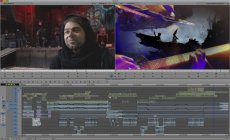Avid video editing software

Avid Media Composer (Best in Class)
(Mac + Windows)
Street price: “…it’s complicated.”
Yeah, I gotta go with Avid Media Composer. This is the default workhorse tool of television and film. Its long evolution has been torturous and expensive for video editors. It has been agonizing and exasperating for Avid’s internal developers. The company has edged near death more than once. But the software is now mature, solid, stable and (dare I say) a little sexy in its own stodgy way.
With your purchase of Media Composer you, today, stand tall upon a huge pile of mangled souls—bruised professional users and wounded former Avid employees—who have fought for a quarter-century (often against one another) to fix bugs and forge the ragged frontier of non-linear editing. You benefit from their years of toil and frustration. Shed a tear. Say a prayer. Salute them.
Now go edit your little tush off. Because, with Media Composer, there's hardly anything you can't do.
But sometimes Media Composer’s way of getting you there is Byzantine. It takes a while to turn a massive ship at sea. Avid has been lagging behind smaller, more nimble companies in several innovations. There’s no lack of engineering acumen at Avid; it’s more about the need to ensure any new feature is compatible with a much larger user-base than most competitors. When those customers are enterprise-class pros (most Avid users are), there’s great demand for stable performance on existing (“sunk cost”) hardware.
 Avid’s competitors were quicker to let you work directly with native media formats. Avid began to address this with Media Composer 7’s Avid Media Access (AMA) protocol. But AMA’s implementation wandered down bit of a bumpy road. In Media Composer 8, AMA percolates mixed resolutions much more smoothly.
Avid’s competitors were quicker to let you work directly with native media formats. Avid began to address this with Media Composer 7’s Avid Media Access (AMA) protocol. But AMA’s implementation wandered down bit of a bumpy road. In Media Composer 8, AMA percolates mixed resolutions much more smoothly.
You can drag and drop media files into a bin—which initiates an Import, transcoding and cloning as needed. Holding down modifier keys (Alt on Windows/Option on Mac) instead conjures an AMA link, essentially creating an Alias in your bin and accessing the media without importing. You can color-code such clips, so a glance at your timeline will tell you what’s native in the session and what is linked. All of this “AMA-ing” (yes, it’s now a verb) can speed your workflow, as long as the needed media drives are connected during your final Export.
Avid now also lets you transcode in the deep background, meaning you can set a list of mixed-media clips to wash, dry and fold themselves any time the CPU is active, even if you quit Media Composer entirely. It reminds me of the old school days of batch-process code compiling, but now with terabytes of 4K, 3D and HDR.
But the speed and crashworthiness of your workflow is still inversely proportional to the amount of transcoding needed. If you can set your project up to ingest a single format, Avid will fly like the industrial strength power plant you have a right to expect. Mixing resolutions puts a tax on your hardware; usually not a big deal, but it can get seriously squishy if you’re on an older CPU.
Source: www.tomshardware.com

|
Avid Media Composer 6 Software (Avid)
|
You might also like:




|
Red Giant Trapcode Shine V1.6, Plug in Video Editing Software for Mac & Windows PC Accessory (Red Giant)
|




|
Avid Liquid v7 Video Editing Software -Academic Version Software (Avid Technology)
|

|
Adobe Premiere Pro CC Digital Software (Adobe)
|

|
Dazzle DVD Recorder HD VHS to DVD Converter Software (Pinnacle Systems)
|
![[1gq] avid liquid 7 video editing software full version](/img/video/1gq_avid_liquid_7_video_editing.jpg)
![Avid Media Composer First [Free Video Editing Software]](/img/video/avid_media_composer_first_free_video.jpg)








You can use one of the following software expect sony vegas:
AVS Video Editor (for windows)
Final Cut Pro (for mac)
Adobe Premiere (for windows)
It's very expensive. Avid Xpress Pro Studio HD $1,695, Avid Media Composer $2,495, Avid Liquid $999. Thanks for using
Please provide which edition of the software 'Avid' you would like. Prices range from $155.00 through $9,995.00. on!